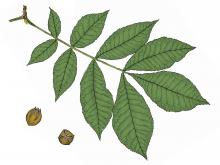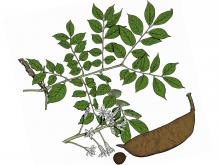Trees, Shrubs and Woody Vines
Media

Species Types
Scientific Name
Gleditsia triacanthos
Description
Though it doesn’t reach a stately size, honey locust commands respect for its many large, strong, usually branched thorns, which can puncture tractor tires as easily as they can poke through tennis shoes! The long, leathery, twisting pods are relished by cattle and by wildlife.
Media

Species Types
Scientific Name
Carya cordiformis
Description
Of the several hickories in Missouri, bitternut hickory is the only one with long, bright yellow buds. Its common name refers to the bitter taste of the nut — but the flavor doesn't put off squirrels, mice, and deer!
Media

Species Types
Scientific Name
Carya illinoinensis
Description
The pecan, a type of hickory, is one of Missouri’s favorite nut trees. Originally pecan had a fairly limited, southern distribution, but today it is found in and out of cultivation nearly statewide, owing to the popularity of the nuts.
Media

Species Types
Scientific Name
Gymnocladus dioicus
Description
There’s no mistaking Kentucky coffee tree when its large, tough seedpods are hanging from its limbs or dropping to the ground below. Unpopular as food with today’s wildlife, these seedpods might have fed mastodons and other large, extinct North American mammals.
Media

Species Types
Scientific Name
Carya spp.
Description
Hickories are an important part of Missouri’s oak-hickory woodlands and forests. They have tremendous economic value, too. Learn about the nine species of hickory found in Missouri.
Media

Species Types
Scientific Name
Zanthoxylum americanum
Description
Common prickly ash is a thicket-forming shrub or small tree. Its compound leaves resemble of those of ash trees, but it’s in a different family. Pairs of stout, curved prickles occur at each node. Scattered statewide, but less common in the Ozarks.
See Also
About Trees, Shrubs and Woody Vines in Missouri
There are no sharp dividing lines between trees, shrubs, and woody vines, or even between woody and nonwoody plants. “Wood” is a type of tissue made of cellulose and lignin that many plants develop as they mature — whether they are “woody” or not. Trees are woody plants over 13 feet tall with a single trunk. Shrubs are less than 13 feet tall, with multiple stems. Vines require support or else sprawl over the ground.





















